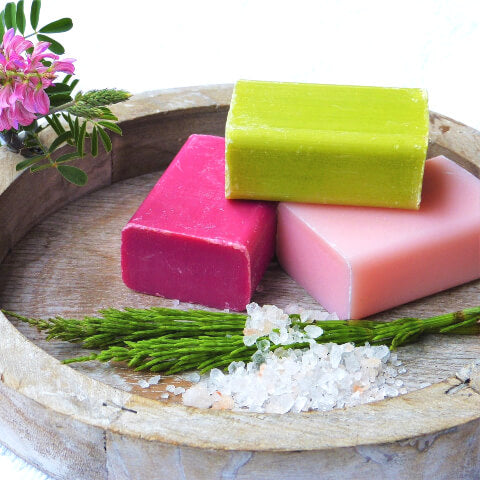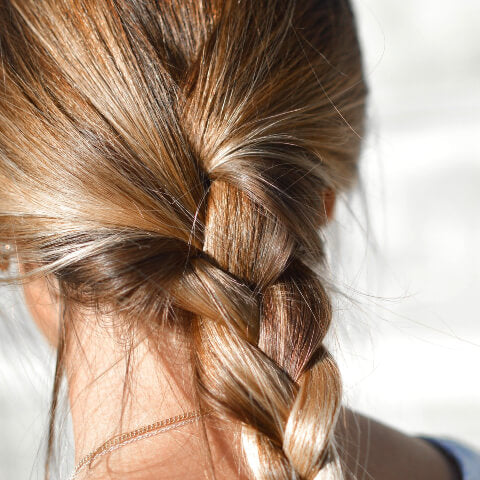*** FREE Shipping On All Orders Over £35! ***
*** FREE Shipping On All Orders Over £35! ***
Can Shampoo Bars Damage Hair?
December 04, 2023 12 min read 3 Comments

Before you select the best available shampoo bar and conditioner bars that suit your hair you need to know a little bit more about hair care in general.
These days we don’t expect a shampoo to simply clean away dirt and grease, we also expect the best shampoo to have a secondary function; to condition and beautify our hair.
To achieve this you need to remove just enough sebum for the hair to be clean whilst simultaneously leaving behind enough conditioning agents to leave the hair soft, shiny, and manageable.
This fine balance is possible by using the right balance of ingredients at the shampoo formulation stage with anionic and amphoteric surfactants, cationic polymers, film formers, humectants, moisturisers, and more.
The word ‘shampoo’ comes from the Indian ‘champoo’ a Hindi word meaning ‘to press or massage’ hair through cleaning. The very first shampoo came onto the market in the 1930s, so for the last 90 years we have stopped using ‘soap’ bars as a cleaner for our hair - and there’s a very good reason for that!
A proper definition of a shampoo is a cleaning agent that ‘does not leave a soap residue’, unfortunately, soap does leave a residue which means that ‘soap’ is not a shampoo.
All too frequently I am asked questions regarding soaps and shampoos such as:
- Is it OK to use soap on hair?
- What happens if you wash your hair with soap?
- Does soap cause hair loss?
- Can you wash your hair with hand soap?
- Which soap is best for hair?
- Why has my 'shampoo' bar ruined my hair?
These kinds of questions, all coming from quite rightly concerned consumers of other products, shows that there is a 'grey' knowledge area surrounding this important topic that needs clarification - so read on for your answers!
Meanwhile, why not try our super foaming natural shampoo bars with gentle, lathering surfactants and plant-based foam booster to reduce build-up and leave your hair shiny and clean?
1 - What Defines A Soap?
Soap is the oldest surfactant known to man. Surfactants are, to give them their full long name, surface cleaning agents. These include the bubbling, foaming, lathery cleaners that remove dirt and grease from our clothes, skin, hair, carpets, dishes and so much more.
They are the primary ingredients, of which there are four categories.
The largest of these four categories is the ‘anionic’ surfactants (the negatively charged foaming cleaners) found in our laundry detergents, washing-up liquids, cleaners, shampoos, shower gels, and soaps.
Also, as these surfactants make it possible to mix oil and water, incredibly they can be found in everyday products which we eat such as mayonnaise, as well as products we put on our skin such as lotions and creams.
Traditional soap (also anionic) has been around for hundreds of years and was made using animal fats and wood ash - which is mainly potassium carbonate - that when heated with some water would release lye (sodium hydroxide). The lye (being extremely alkaline, measuring a pH14 on the pH scale of 0-14 with pH 7 being neutral) is needed to turn the oils into soap through a process called ‘saponification’.
Nowadays soap is made with vegetable oils and store-bought lye (Sodium hydroxide) and requires careful handling.
However, the result of this sort of soap-making is still a very alkaline product (with a pH 9 to 11) and scientific research has shown that this causes issues for our hair.
2. The 5 Reasons NOT To Use Soap On Your Hair?
If you're one of those unfortunate people that tried what you thought was a shampoo bar and now think that shampoo bars ruined your hair then read on.
A proper shampoo bar, not a soap bar, will not ruin your hair - and that's probably why you are here reading this to find out what the problem is/was. Have faith, as in many cases as long as they are the real deal, they can be better for your hair than liquid shampoo which usually contains up to 80% water!
The hair shaft’s outermost layer is the ‘cuticle’ and is made up of flattened cells that overlap like tiles on a roof.
Years of scientific research (see some references below) have found that if you use soap (and other alkaline surfactants) to shampoo your hair it damages it in several ways:
- One:- alkaline products can increase the negative electrical charge of the hair. This may lead to cuticle damage and fibre breakage. It is a reality and not a myth that lower pH of shampoos may cause less frizzing and generate less negative static electricity on the fibre surface.
- Two:- the outer layer of cuticle cells will not lay flat and the cells then catch on each other causing friction, knots, and tangles when alkaline products are used. In some cases, it can lead to the permanent ripping of scales leaving the inner cortex open to potentially more damage.

- Three:- the cuticle is covered in a fine layer of ‘covalently bound hair lipids’ made up of fatty acids. Their function is to protect the cuticle, help reduce friction, and also to repel water. Alkaline products are known to strip these fatty acid lipids. Over time, this will start to affect the overall health of the hair as the conditioning ingredients (that are positively charged and naturally attracted to these fatty lipids) can’t ‘adsorb’ to them and offer the properties that give our hair that conditioned look, feel and shine.
- Four:- this protective lipid layer, there is another negative effect which is that the hair becomes more water-loving (hydrophilic). This happens when the hair has been damaged and leads to more water entering and swelling the hair shaft, lifting the cuticle cells and resulting in even more friction and damage.
- Five:- in contact with water 'leaves an alkaline residue that is harmful to the hair in the form of calcium salts which accumulate in the hair strands, leaving them opaque and tangled’. This soap ‘scum’ can also cause itching, exacerbate redness, scaly patches, and dandruff (seborrheic dermatitis), and leave the hair dull. Also, if hair becomes very alkaline and porous, the cuticle cannot retain the colour as the cuticle fails to hold the new pigments and the colour will rinse out prematurely, so not good for coloured hair either.
(Note: Using an acidic cider vinegar rinse will not undo the damage caused by an alkaline product.)
The hair follicle, otherwise known as the hair root, is the living part of the hair located beneath the surface of the skin. Humans have almost five million hair follicles, 80,000 to 100,000 of which are located on our scalp. The hair follicle is the growth structure that produces the hair, and it also anchors the hair shaft in the skin. The hair follicle is made up of four parts:
- Hair Bulb - located at the base of the hair follicle. This is where cells divide to form the hair shaft in a continuous cycle of growth and rest, otherwise known as the hair growth cycle. The hair bulb’s anatomy is made up of the papilla and the matrix. The papilla, located at the base of the hair bulb, contains a vascular network that nourishes the hair bulb with nutrients. Through this blood supply, the dermal papilla also receives hormonal signals that help regulate hair growth.
- Sebaceous Gland - produces an oily substance called sebum that moisturizes both the hair shaft and the skin.
- Inner and Outer Root Sheath - these protein structures contain and protect the hair follicle.
- Arrector Pili Muscle - is a small muscle attached to the hair follicle. When the arrector pili muscle contracts, it causes the hair to stand on end. This is what causes goosebumps.
Damage to the hair shaft can cause breakage, limiting hair length, which can make it seem like hair growth has slowed down. If you take up healthy hair care habits, like using the best and right shampoo for your hair, reducing heat styling, stopping chemical straightening treatments, and no bleaching this can help minimize breakage and damage.
So maybe, just maybe, if you are one of those unlucky people that considers that "a shampoo bar ruined my hair" perhaps it wasn't a REAL shampoo bar at all. I'm afraid it does happen.
There are a lot of hair care bars on the market of dubious origin and ingredients that purport to be real shampoo bars but, if you examine them closely, you will find that they are no more than your average soap bar - that explains why many of them look so cheap; because they have poor quality inferior ingredients.
Don't be disheartened, read on in the next paragraph which will help you in your quest for a REAL shampoo bar and no more ruined hair.
3. Is My Shampoo Bar Really A Soap Bar In Disguise?
Just because it says 'shampoo on the label doesn't mean that it is one - in fact in a large proportion of cases it most certainly isn't but is a soap bar in disguise! So there are a few things you can investigate for yourself.
Firstly look at the price. Soap uses far less expensive ingredients than those found in formulated shampoos. Both lye and carrier oils are inexpensive, so these soap bars can start from just a couple of pounds.
The main cost in these bars are the herbs (if large amounts are needed to be infused into the oils) and the essential oils that are added for their natural scent and other therapeutic benefits. Many essential oils are too expensive to use in soap or their scents are too delicate and lost through the lye process.
Whilst man-made fragrances survive the soap-making process and are inexpensive, they have their issues and can cause skin irritations, rashes, headaches, and more.
Secondly, check the ingredients. If the label states just a bunch of oils as the ingredients or names such as ‘Sodium Olivate’, ‘Sodium Cocoate’. These, for example, are the terms used for Olive Oil and Coconut Oil after the ‘saponification’ process - turning carrier oils into soap.
They have been combined with the very alkaline Lye to make a bar of soap. A popular ingredient in soap bars is ‘Sodium Palmate’ – palm oil saponified, as it adds both hardness and foam to soap bars, though we all know the current environmental effects of using palm oil!
To clarify this a bit further, when 'fake' shampoo bars, with a cheaper lye base, are made the manufacturers usually add a significant number of oils - such as coconut, olive, and palm, often all three and maybe others too - to create a hardened bar.
These oils are mixed with the lye (an alkali substance) and a process called saponification takes place, i.e. the production of soap and glycerol.
As the oils are composed of fatty acids, they require a certain amount of alkali to saponify them or change them into soap. This is an important step in soap-making and when done correctly should leave you with no lye left in the end article, which will be a hardened soap substance - but this is to create soap, not a shampoo.
During the saponification process there is a change to the oils as follows:
- when castor oil is saponified it is called Sodium Castorate or Sodium Ricinoleat
- when coconut oil is saponified it is called Sodium Cocoate
- when palm oil is saponified it is called Sodium Palmate
- when olive oil is saponified it is called Sodium Olivate
- when shea butter is saponified it is called Sodium Sheabutterate
- when sunflower oil is saponified it is called Sodium Sunflowerate
- and so on.
Oils in their pure form are 'generally' fine and are added to shampoos in small quantities. It is when you see the 'sodium' word prefix before an oil name that is the key indicator that they have been saponified and therefore used to create a soap.
There are also many imported inexpensive soap bases (some with the Glycerine removed, a natural humectant that draws moisture to your body that is sold off to lotion companies for profit), leaving the skin feeling rough and dry. All these types of soap bars are usually fine to use on the body but not for the hair and scalp.
This is because your skin has an approximate pH of 5.5 and will replace the acid mantle (an acid film barrier on the surface of the skin) that when washed away by soap will replace itself in under an hour of washing. Crucially, this acid mantle is not found on the hair and thus leaves it wide open to damage from alkaline products.
Other alkaline surfactants are now also proving popular in shampoo bars, such as ‘Sodium Coco Sulfate’ and ‘Decyl glucoside’ (ranging from pH 7.5 - 12.5).
Unless there is an acidic element to the formulation, these alkaline ingredients are not going to prove much better than soap.
Sodium lauryl sulfate (SLS) is another alkaline surfactant that is inexpensive and harsh, commonly found in household cleaning products, and also used to clean car engines. It has a small molecular structure that penetrates the skin and causes irritation with much research also stating other negative long-term side effects.
So if you have been using what you think is a proper shampoo bar and have had adverse reactions such as an itchy scalp afterward, or even suffered some mild hair loss, then you might want to check the label ingredients one by one and also exactly where that shampoo bar was made!
Are the ingredients natural or synthetic?
If the shampoo has a scent, is this created from fragrance oils or essential oils?
Unfortunately not every shampoo bar manufacturer is up to the job, some of them are almost 'rogue' in their behaviours. Also, as outlined above, many produce just soap bars masquerading as shampoo bars and shouldn't be allowed to use the title.
Possibly even worse than that are some of the imported 'so-called' shampoo bars that are manufactured overseas, where there is little if any control or oversight of their manufacture or ingredient inclusions, which are not fit for purpose.
Once again, if in doubt check the label again carefully - if what you are about to purchase or have used already, was at bargain basement price then the chances are strong that you have been using a 'fake' product.
So, as mentioned above, it probably wasn't a shampoo bar that ruined your hair but some sort of soap bar in 'disguise'.
As is said in many other spheres of purchase, if something seems too good to be true it usually is - so always, caveat emptor!
4. What To Look For In The Best Shampoo Bar UK!
Ideally, the best shampoo bar should have a pH-balanced variety of anionic and amphoteric co-surfactants (we use no less than five). Surfactants with a larger molecular structure (SLS free) that are gentle to the scalp and impart excellent foaming and lathering properties that together will also work to increase mildness, thickness, and viscosity.
If you have one or two anionic powdered surfactants only which I’ve also seen, this can be a little harsh on the hair, as a shampoo bar is a concentrated form after all.
There should also be cationic emulsifiers (such as BTMS that leaves hair feeling soft and conditioned), eco-friendly silicon alternatives (ideally vegan plant-based alternatives that will increase the conditioned feel as well as decrease static and friction), proteins, and film formers (that will create a protective coating over the hair strands and decrease friction) and a humectant, moisturizer and shine improver such as pro-Vitamin B5.
Ideally finding these ingredients in a palm oil-free and vegan version (as we have) though it has been a long, hard process to do so.
A note for those with fine hair, a conditioner containing a cationic quaternary compound such as ‘Cetrimonium chloride’ is good as well as a mix of proteins (both are found in our conditioner bars) as fine hair has a smaller diameter than other hair types and more cuticle, so is more static and fly-away.
5. The Benefits Of Using The Best Shampoo Bar Over Conventional Liquid Shampoo.
Not only are the best shampoo bars highly convenient, and fit well into our busy lifestyles, they are easy to travel with and leak-free. As they aren’t diluted with huge amounts of water, they are also not bulky or heavy either and of course, they are free of plastic, making them a very eco-friendly, contemporary solution. However, they also need to do the job of proper shampoo.
The Solid Bar Company have formulated their in our best UK shampoo bars and all natural conditioner bars over the past five years to bring you the best ingredients for your hair and allow you to truly make the permanent switch away from diluted formulations in plastic bottles.
What makes them even more beneficial to liquid shampoos is that shampoo bars can be formulated to cover a whole host of different hair types in one bar in a way you cannot do with a liquid shampoo (which can only use specific, liquid surfactants and limited ingredients which then has to be targeted for specific hair formulations and types, such as curly hair, fine hair, anti-frizz, clarifying, etc.).
This is because you can add so many more emollients to a water-less shampoo bar as well as moisturising butters, BTMS (highly conditioning ingredient), and cetyl alcohol (a vegetable-derived emollient that in itself adds moisture and boost any cationic quaternary compound ingredients).
If these were added to liquid shampoos and conditioners at the formulation stage, they would just separate (believe me, I have done it). This is because they won’t mix with anionic surfactants and water. However, as water isn’t added until we wash our hair with a shampoo bar or conditioner bar, the bar can’t separate and we get the benefit of all those lovely ingredients.
For fantastic hair care products and to get 10% off your order using checkout code THANK YOU.
Don't forget to check out the full range of natural shampoo bars here.
Best wishes,
Rebecca and The Solid Bar Company Team
PS. And while you are here be sure to read A Complete Guide To Shampoo Bars
References:
- Hair Cosmetics – An Overview
- Shampoos and Conditioners – What a Dermatologist Should Know
- Analysis of Hair Lipids
- Essentials of Hair Often Neglected
(This blog post information was updated in December 2023)
3 Responses
Rebecca - The Solid Bar Company CEO
July 09, 2020
Hi Paula – thanks for your question – as a surfactant, or cleaning agent, you will find Sodium Cocoyl Isethionate in bar soaps and bar shampoos and even in some liquid versions of both too. You will, historically, have seen it as an ingredient in soap bars but that is primarily due to the fact that it is usually produced in solid (powder or flake) form as a coconut derived product. In tandem with this it also has a relatively high melting point and can be considered hard to dissolve in water. However, over time with our carefully researched and tested formulations we have found ways to include this mild on the skin yet very effective foaming agent as a key ingredient in our shampoo bars. Best wishes, Rebecca
Paula Beaton
July 09, 2020
Is Sodium Cocoyl Isethionate a shampoo bar ingredient or is this more commonly found in soaps?
Leave a comment
Comments will be approved before showing up.

10% Off Your Order Today By Signing Up To Our Newsletter!
Then use discount code THANK YOU at checkout!






Frances England
May 22, 2021
Thanks for posting this! I tried a sample of a shampoo bar because I was unsure to switch or not. I had a bad experience because it made my hair feel like I washed it with a bar of soap. But after reading this, I am starting to think it might have been soap posing as shampoo. I am gonna give bar shampoo another try, and now I have the knowledge to know what to look for in the ingredients.